Reservoir Characteristics and Diagenetic Evolution of Lower Cretaceous in Baibei Sag, Erlian Basin, Northern China
Abstract
1. Introduction
2. Geological Setting
3. Materials and Methods
4. Results
4.1. Core Observation
4.1.1. Lithological Observation
4.1.2. Sedimentary Facies
4.2. Sandstone Petrology
4.2.1. Sandstone Composition and Texture
4.2.2. Clay Mineral
4.3. Reservoir Characteristics
4.3.1. Porosity and Permeability
4.3.2. Pore Throat Types
4.3.3. Pore Throat Structure Characteristics
5. Discussion
5.1. Type of Diagenesis
5.1.1. Compaction
5.1.2. Cementation
5.1.3. Dissolution
5.2. Diagenetic Sequence
5.2.1. Early Diagenetic Stage
5.2.2. Middle Diagenetic Stage
5.3. Controlling Factors of Reservoir Physical Properties
6. Conclusions
- The Lower Cretaceous sandstone in the Baibei Sag is primarily feldspathic lithic sandstone. The clastic particles are mainly composed of 44.3% rock fragments, 34.6% quartz, and 21.2% feldspar. The average content of clay minerals is 19.7%, with illite (69.3%) and I/S (12.7%) as the dominant minerals, and smaller amounts of chlorite (10.9%) and kaolinite (7.2%). The content of smectite is very low.
- The effective porosity of the Tengger Formation sandstone reservoir is 3.3%, with an average permeability is 0.01 × 10−3 μm2. For the Aershan Formation sandstone reservoir, the average effective porosity is 0.86%, with an average permeability of 0.05 × 10−3 μm2. Both the Tengger and Aershan formations are classified as tight sandstone reservoirs, and the reservoir space is primarily dominated by dissolution pores.
- Three types of pore throat structures (HPMI curve: Type 1, Type 2, and Type 3) were identified, corresponding to different pore throat radius distributions (RCP curve: Type 1, Type 2, and Type 3). The pore throat structures of these three types are mainly controlled by mineral composition. And the pore models for different types of reservoirs have been established.
- The maximum burial depth of the Aershan formation reached 2850 m, and the porosity rapidly decreased due to strong compaction. In addition, cementation dominated by carbonate minerals further reduces porosity. The fine-grained argillaceous deposits of deep lake and semi-deep lake facies in K1a2 and other mudstone intercalations formed the organic acid fluid in the evolution process. The organic acid fluid promoted the dissolution and formed the main reservoir space in the study area. The early tectonic fractures in the study area were filled with calcite, and the residual small-scale fractures played a positive role in material migration. Combined with the burial history and organic matter evolution characteristics, the diagenetic evolution sequence of the lower Cretaceous sandstone reservoir is established. The lower Cretaceous Tengger Formation and Arshan Formation reservoirs have entered the middle diagenetic stage A.
Author Contributions
Funding
Data Availability Statement
Conflicts of Interest
References
- Xing, Y.; Zhang, Y.; Jiang, S.; Dong, X.; Wang, Y.; Wang, H.; Xu, Y. Characteristics and distribution of oil and gas reservoirs in the Wulanhua Sag of the Erlian Basin. China Pet. Explor. 2020, 25, 68. [Google Scholar]
- Dou, L.; Chang, L. Fault linkage patterns and their control on the formation of the petroleum systems of the Erlian Basin, Eastern China. Mar. Pet. Geol. 2003, 20, 1213–1224. [Google Scholar] [CrossRef]
- Si, W.; Hou, D.; Cao, L. Characterization of Crude Oil, Formation Water, and Fluid Inclusions of Hydrocarbon-Bearing Strata and Their Hydrocarbon Geological Significance in the Wuliyasitai Southern Sub-Sag of the Erlian Basin, China. ACS Omega 2023, 8, 29060–29082. [Google Scholar] [CrossRef] [PubMed]
- Li, L.; Tang, D.; Xu, H.; Tao, S.; Chen, S.; Tang, S.; Yao, H. Coalbed methane geology and exploration potential in large, thick, low-rank seams in the Bayanhua Sag of the Erlian Basin, northern China. Energy Explor. Exploit. 2022, 40, 995–1022. [Google Scholar] [CrossRef]
- Sun, F.; Li, W.; Sun, Q.; Sun, B.; Tian, W.; Chen, Y.; Chen, Z. Low-rank coalbed methane exploration in Jiergalangtu Sag, Erlian Basin. Acta Pet. Sin. 2017, 38, 485. [Google Scholar]
- Bonnetti, C.; Malartre, F.; Huault, V.; Cuney, M.; Bourlange, S.; Liu, X.; Peng, Y. Sedimentology, stratigraphy and palynological occurrences of the late cretaceous Erlian formation, Erlian Basin, Inner Mongolia, People’s Republic of China. Cret. Res. 2014, 48, 177–192. [Google Scholar] [CrossRef]
- Chen, G.; Wang, T.; Li, L.; Li, S.; Li, J. Characteristics of a sublacustrine fan in a half-graben rift lake basin and its petroleum prospects: Case study on the second member of the Tenggeer Formation, Saihantala Sag, Erlian Basin. Pet. Explor. Dev. 2010, 37, 63–69. [Google Scholar] [CrossRef]
- Wang, S.; Shao, L.; Wang, D.; Sun, Q.; Sun, B.; Lu, J. Sequence stratigraphy and coal accumulation of Lower Cretaceous coal-bearing series in Erlian Basin, northeastern China. AAPG Bull. 2019, 103, 1653–1690. [Google Scholar] [CrossRef]
- Ren, J.; Tamaki, K.; Li, S.; Junxia, Z. Late Mesozoic and Cenozoic rifting and its dynamic setting in Eastern China and adjacent areas. Tectonophysics 2002, 344, 175–205. [Google Scholar] [CrossRef]
- Wang, P.J.; Mattern, F.; Didenko, N.A.; Zhu, D.F.; Singer, B.; Sun, X.M. Tectonics and cycle system of the Cretaceous Songliao Basin: An inverted active continental margin basin. Earth-Sci. Rev. 2016, 159, 82–102. [Google Scholar] [CrossRef]
- Gao, Y. Hydrocarbon accumulation conditions research and favorable zones prediction of Baibei Sag in Erlian Basin. Pet. Geol. Eng. 2015, 29, 38–41. [Google Scholar]
- Zheng, L.W.; Dong, S.N.; Lin, J.; Liang, D.Y.; Hou, J.; Qiu, W.B. Characteristics and distribution patterns of the Tengger Formation reservoir in Baibei Sag of Erlian Basin. Sci. Technol. Eng. 2019, 19, 141–150. [Google Scholar]
- Bai, X.Y.; Liu, H.C.; Li, K.S.; Chen, Z.J.; Han, C.C. Geologic characteristics and petroleum exploration potential of Baibei Sag in Erlian Basin. J. Yanan Univ. 2016, 35, 89–92. [Google Scholar]
- Liu, H.; Ren, J.; Lyu, J.; Lyu, X.; Feng, Y. Hydrocarbon source rock evaluation of the Lower Cretaceous system in the Baibei Depression, Erlian Basin. Energy Explor. Exploit. 2018, 36, 355–372. [Google Scholar] [CrossRef]
- Li, J.H.; Yu, L.; Shuai, J. The geochemical characteristics of source rocks in Baibei Depression of Erlian Basin. Ground Water 2016, 38, 248–250. [Google Scholar]
- Olson, J.E.; Laubach, S.E.; Lander, R.H. Natural fracture characterization in tight gas sandstones: Integrating mechanics and diagenesis. AAPG Bull. 2009, 93, 1535–1549. [Google Scholar] [CrossRef]
- Henares, S.; Caracciolo, L.; Cultrone, G.; Fernández, J.; Viseras, C. The role of diagenesis and depositional facies on pore system evolution in a Triassic outcrop analogue (SE Spain). Mar. Pet. Geol. 2014, 51, 136–151. [Google Scholar] [CrossRef]
- Farrell, K.M.; Harris, W.B.; Mallinson, D.J.; Culver, S.J.; Riggs, S.R.; Wehmiller, J.F.; Moore, J.P.; Self-Trail, J.M.; Lautier, J.C. Graphic Logging for Interpreting Process-Generated Stratigraphic Sequences and Aquifer/Reservoir Potential: With Analog Shelf to Shoreface Examples from the Atlantic Coastal Plain Province, USA. J. Sediment. Res. 2013, 83, 723–745. [Google Scholar] [CrossRef]
- Law, B.E.; Curtis, J.B. Introduction to unconventional petroleum systems. AAPG Bull. 2002, 86, 1851–1852. [Google Scholar]
- Zou, C.; Tao, S.; Han, W.; Zhao, Z.; Ma, W.; Li, C.; Bai, B.; Gao, X. Geological and geochemical characteristics and exploration prospect of coal-derived tight sandstone gas in China: Case study of the Ordos, Sichuan, and Tarim Basins. Acta Geol. Sin. Engl. Ed. 2018, 92, 1609–1626. [Google Scholar] [CrossRef]
- Li, M.; Guo, Y.; Li, Z.; Wang, H. The diagenetic controls of the reservoir heterogeneity in the tight sand gas reservoirs of the Zizhou Area in China’s east Ordos Basin: Implications for reservoir quality predictions. Mar. Pet. Geol. 2020, 112, 104088. [Google Scholar] [CrossRef]
- Beig, M.S.; Lüttge, A. Albite dissolution kinetics as a function of distance from equilibrium: Implications for natural feldspar weathering. Geochim. Cosmochim. Acta 2006, 70, 1402–1420. [Google Scholar] [CrossRef]
- Crundwell, F.K. On the mechanism of the dissolution of quartz and silica in aqueous solutions. ACS Omega 2017, 2, 1116–1127. [Google Scholar] [CrossRef]
- Higgs, K.E.; Zwingmann, H.; Reyes, A.G.; Funnell, R.H. Diagenesis, porosity evolution, and petroleum emplacement in tight gas reservoirs, Taranaki Basin, New Zealand. J. Sediment. Res. 2007, 77, 1003–1025. [Google Scholar] [CrossRef]
- Mørk, M.B.E. Diagenesis and quartz cement distribution of low-permeability Upper Triassic–Middle Jurassic reservoir sandstones, Longyearbyen CO2 lab well site in Svalbard, Norway. AAPG Bull. 2013, 97, 577–596. [Google Scholar] [CrossRef]
- Nabawy, B.S.; Rochette, P.; Géraud, Y. Petrophysical and magnetic pore network anisotropy of some cretaceous sandstone from Tushka Basin, Egypt. Geophys. J. Int. 2009, 177, 43–61. [Google Scholar] [CrossRef]
- Lai, J.; Wang, G.; Cai, C.; Fan, Z.; Wang, S.; Chen, J.; Luo, G. Diagenesis and reservoir quality in tight gas sandstones: The fourth member of the Upper Triassic Xujiahe Formation, Central Sichuan Basin, Southwest China. Geol. J. 2018, 53, 629–646. [Google Scholar] [CrossRef]
- Chinese Standard SY/T 5368-2016; Identification for Thin Section of Rocks. National Energy Administration: Beijing, China, 2016.
- Chinese Standard SY/T 5163-2010; Analysis Method for Clay Minerals and Ordinary Non-Clay Minerals in Sedimentary Rocks by the X-Ray Diffraction. National Energy Administration: Beijing, China, 2010.
- Chinese Standard SY/T 5346-2005; Rock Capillary Pressure Measurement. National Development and Reform Commission: Beijing, China, 2005.
- Houseknecht, D.W. Assessing the relative importance of compaction processes and cementation to reduction of porosity in sandstones. AAPG Bull. 1987, 71, 633–642. [Google Scholar]
- Tobin, R.C.; McClain, T.; Lieber, R.B.; Ozkan, A.; Banfield, L.A.; Marchand, A.M.; McRae, L.E. Reservoir quality modeling of tight-gas sands in Wamsutter field: Integration of diagenesis, petroleum systems, and production data. AAPG Bull. 2010, 94, 1229–1266. [Google Scholar] [CrossRef]
- Athy, L.F. Density, porosity, and compaction of sedimentary rocks. AAPG Bull. 1930, 14, 1–24. [Google Scholar]
- Olivarius, M.; Weibel, R.; Hjuler, M.L.; Kristensen, L.; Mathiesen, A.; Nielsen, L.H.; Kjøller, C. Diagenetic effects on porosity–permeability relationships in red beds of the Lower Triassic Bunter Sandstone Formation in the North German Basin. Sediment. Geol. 2015, 321, 139–153. [Google Scholar] [CrossRef]
- Cao, B.; Luo, X.; Zhang, L.; Sui, F.; Lin, H.; Lei, Y. Diagenetic evolution of deep sandstones and multiple-stage oil entrapment: A case study from the Lower Jurassic Sangonghe Formation in the Fukang Sag, central Junggar Basin (NW China). J. Pet. Sci. Eng. 2017, 152, 136–155. [Google Scholar] [CrossRef]
- Xu, N.; Qiu, L.; Eriksson, K.A.; Klyukin, Y.I.; Wang, Y.; Yang, Y. Influence of detrital composition on the diagenetic history of tight sandstones with implications for reservoir quality: Examples from the Permian Xiashihezi Formation and Carboniferous Taiyuan Formation, Daniudi gas field, Ordos Basin, China. Mar. Pet. Geol. 2017, 88, 756–784. [Google Scholar] [CrossRef]
- Dutton, S.P. Calcite cement in Permian deep-water sandstones, Delaware Basin, west Texas: Origin, distribution, and effect on reservoir properties. AAPG Bull. 2008, 92, 765–787. [Google Scholar] [CrossRef]
- Loyd, S.J.; Corsetti, F.A.; Eiler, J.M.; Tripati, A.K. Determining the diagenetic conditions of concretion formation: Assessing temperatures and pore waters using clumped isotopes. J. Sediment. Res. 2012, 82, 1006–1016. [Google Scholar] [CrossRef]
- Wang, J.; Cao, Y.; Liu, K.; Liu, J.; Xue, X.; Xu, Q. Pore fluid evolution, distribution and water-rock interactions of carbonate cements in red-bed sandstone reservoirs in the Dongying Depression, China. Mar. Pet. Geol. 2016, 72, 279–294. [Google Scholar] [CrossRef]
- Salem, A.M.; Morad, S.; Mato, L.F.; Al-Aasm, I.S. Diagenesis and reservoir-quality evolution of fluvial sandstones during progressive burial and uplift: Evidence from the Upper Jurassic Boipeba Member, Recôncavo Basin, Northeastern Brazil. AAPG Bull. 2000, 84, 1015–1040. [Google Scholar]
- Schmid, S.; Worden, R.H.; Fisher, Q.J. Diagenesis and reservoir quality of the Sherwood Sandstone (Triassic), Corrib field, Slyne basin, west of Ireland. Mar. Pet. Geol. 2004, 21, 299–315. [Google Scholar] [CrossRef]
- Harris, N.B. Low-porosity haloes at stylolites in the feldspathic Upper Jurassic Ula sandstone, Norwegian North Sea: An integrated petrographic and chemical mass-balance approach. J. Sediment. Res. 2006, 76, 444–459. [Google Scholar] [CrossRef]
- Berger, G.; Lacharpagne, J.C.; Velde, B.; Beaufort, D.; Lanson, B. Kinetic constraints on illitization reactions and the effects of organic diagenesis in sandstone/shale sequences. Appl. Geochem. 1997, 12, 23–35. [Google Scholar] [CrossRef]
- Chuhan, F.A.; Bjørlykke, K.; Lowrey, C. The role of provenance in illitization of deeply buried reservoir sandstones from Haltenbanken and north Viking Graben, offshore Norway. Mar. Pet. Geol. 2000, 17, 673–689. [Google Scholar] [CrossRef]
- Sanjuan, B.; Girard, J.P.; Lanini, S.; Bourguignon, A.; Brosse, E. Geochemical modelling of diagenetic illite and quartz cement formation in Brent sandstone reservoirs: Example of the Hild Field, Norwegian North Sea. Clay Miner. Cem. Sandstones 1999, 34, 425–452. [Google Scholar]
- Henares, S.; Caracciolo, L.; Viseras, C.; Fernández, J.; Yeste, L.M. Diagenetic constraints on heterogeneous reservoir quality assessment: A Triassic outcrop analog of meandering fluvial reservoirs. AAPG Bull. 2016, 100, 1377–1398. [Google Scholar] [CrossRef]
- Saïag, J.; Brigaud, B.; Portier, É.; Desaubliaux, G.; Bucherie, A.; Miska, S.; Pagel, M. Sedimentological control on the diagenesis and reservoir quality of tidal sandstones of the Upper Cape Hay Formation (Permian, Bonaparte Basin, Australia). Mar. Pet. Geol. 2016, 77, 597–624. [Google Scholar] [CrossRef]
- Oluwadebi, A.G.; Taylor, K.G.; Dowey, P.J. Diagenetic controls on the reservoir quality of the tight gas Collyhurst sandstone formation, Lower Permian, East Irish Sea Basin, United Kingdom. Sediment. Geol. 2018, 371, 55–74. [Google Scholar] [CrossRef]
- Morad, S.; Ketzer, J.M.; De Ros, L.F. Spatial and temporal distribution of diagenetic alterations in siliciclastic rocks: Implications for mass transfer in sedimentary basins. Sedimentology 2000, 47, 95–120. [Google Scholar] [CrossRef]
- Surdam, R.C.; Crossey, L.J.; Hagen, E.S.; Heasler, H.P. Organic-inorganic interactions and sandstone diagenesis. AAPG Bull. 1989, 73, 1–23. [Google Scholar]
- Lai, J.; Wang, G.; Chai, Y.; Xin, Y.; Wu, Q.; Zhang, X.; Sun, Y. Deep burial diagenesis and reservoir quality evolution of high-temperature, high-pressure sandstones: Examples from Lower Cretaceous Bashijiqike Formation in Keshen area, Kuqa depression, Tarim basin of China. AAPG Bull. 2017, 101, 829–862. [Google Scholar] [CrossRef]
- Zou, C.N.; Tao, S.Z.; Hui, Z.; Zhang, X.X.; He, D.B.; Zhou, C.M.; Wang, L.; Wang, X.S.; Li, F.H.; Zhu, R.K.; et al. Genesis, classification, and evaluation method of diagenetic facies. Pet. Explor. Dev. 2008, 35, 526–540. [Google Scholar] [CrossRef]
- Giles, M.R. Mass transfer and problems of secondary porosity creation in deeply buried hydrocarbon reservoirs. Mar. Pet. Geol. 1987, 4, 188–204. [Google Scholar] [CrossRef]
- Mozley, P.S.; Heath, J.E.; Dewers, T.A.; Bauer, S.J. Origin and heterogeneity of pore sizes in the Mount Simon Sandstone and Eau Claire Formation: Implications for multiphase fluid flow. Geosphere 2016, 12, 1341–1361. [Google Scholar] [CrossRef]
- Wilkinson, M.; Darby, D.; Haszeldine, R.S.; Couples, G.D. Secondary porosity generation during deep burial associated with overpressure leak-off: Fulmar Formation, United Kingdom Central Graben. AAPG Bull. 1997, 81, 803–813. [Google Scholar]
- Chinese Standard SY/T 5477-2003; The Division of Diagenetic Stages in Clastic Rocks. State Economic and Trade Commission: Beijing, China, 2003.
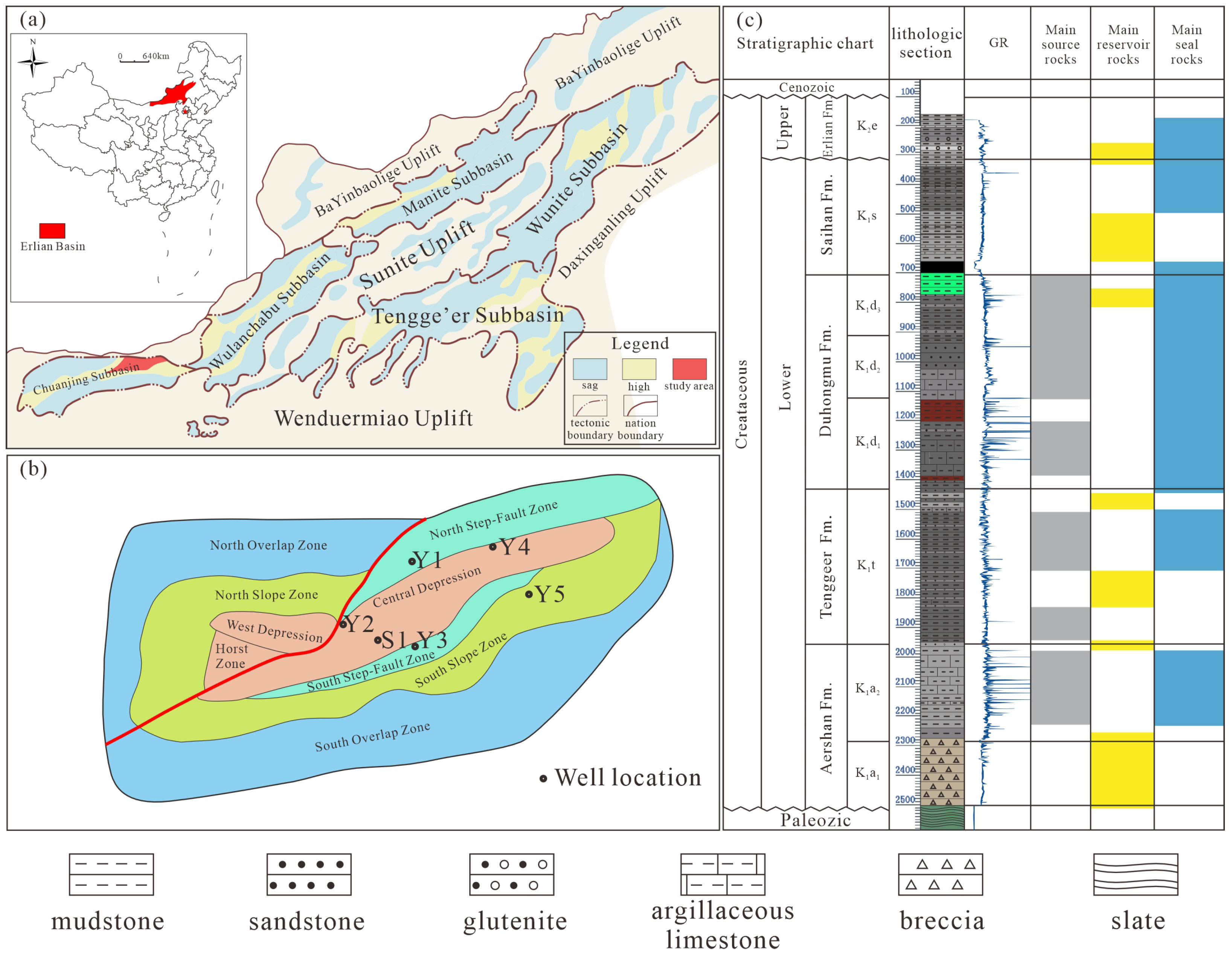
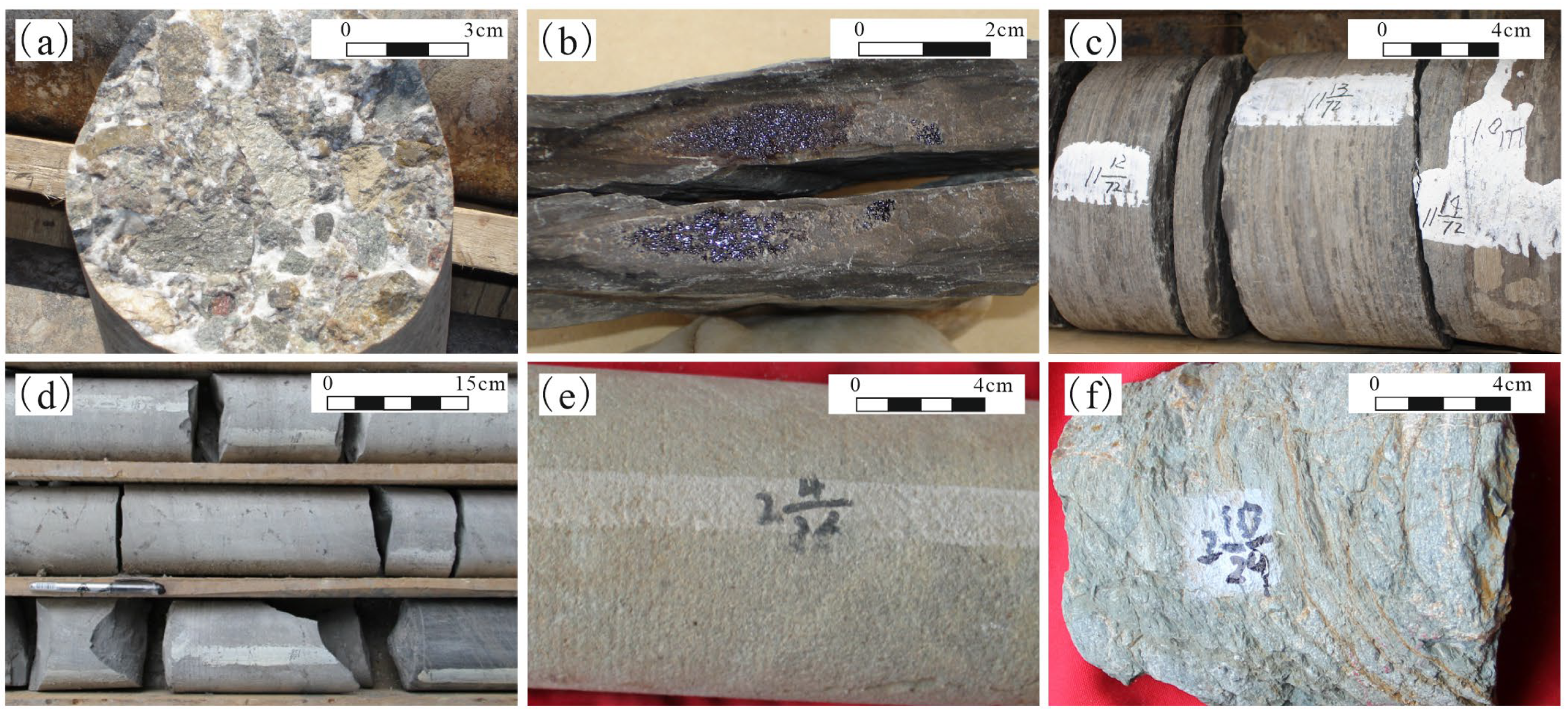

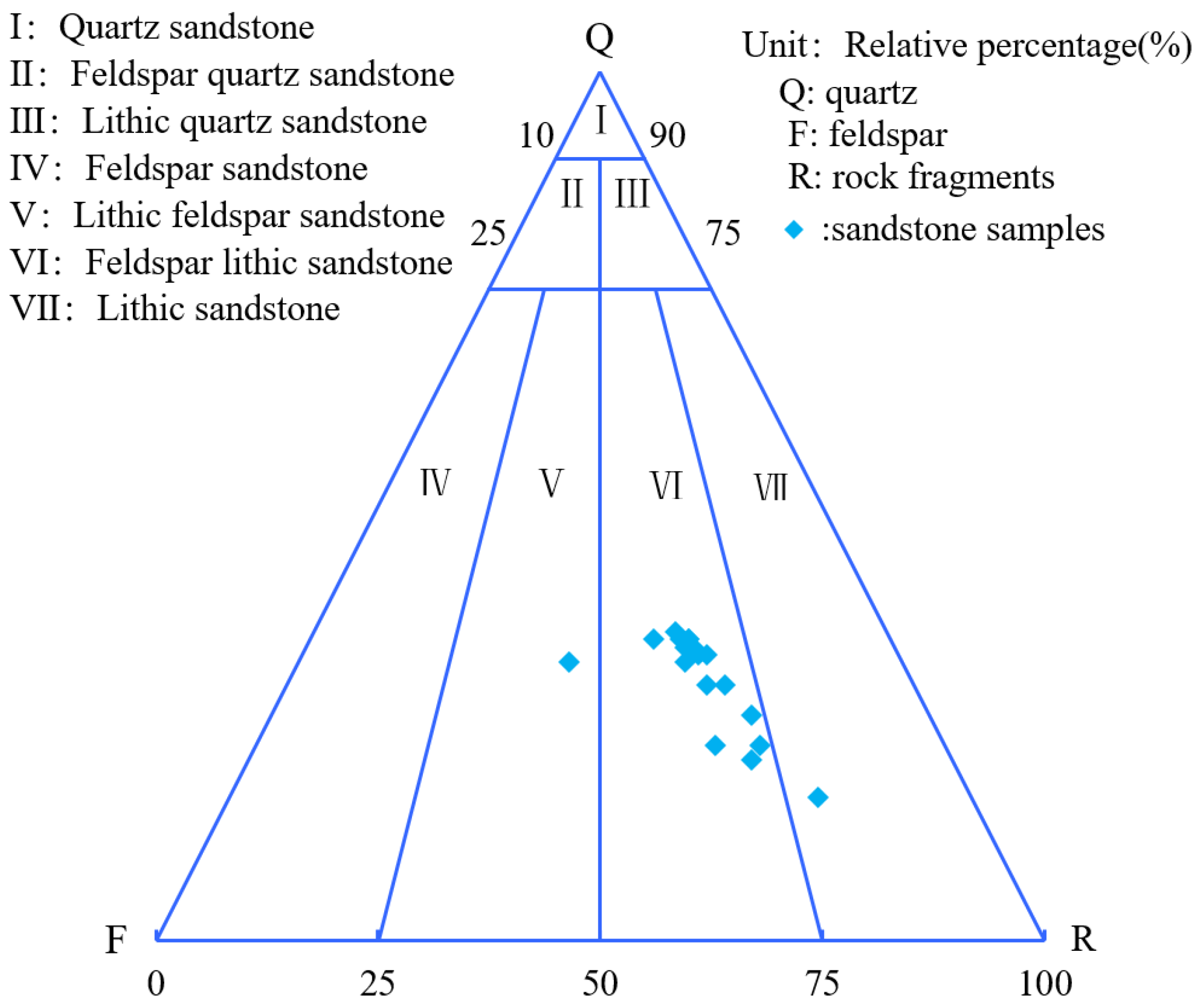
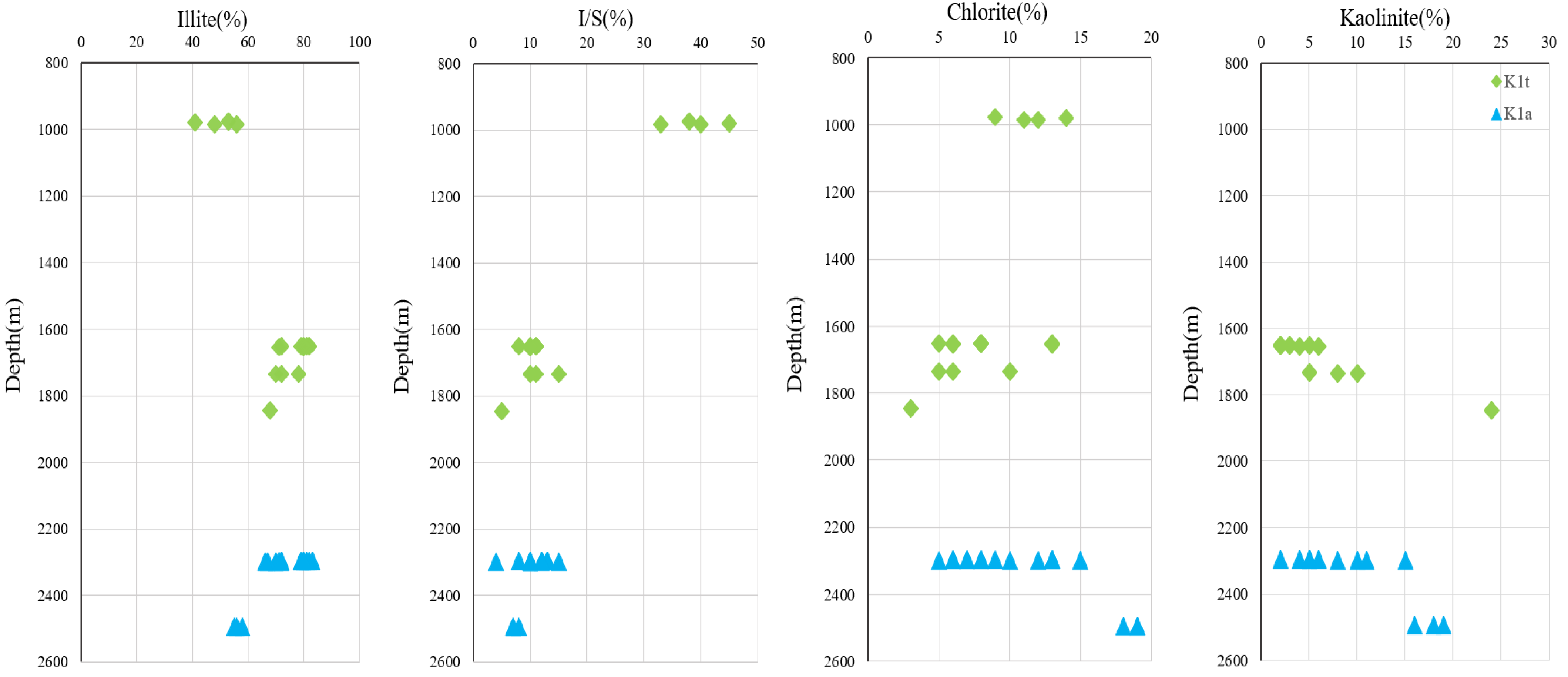
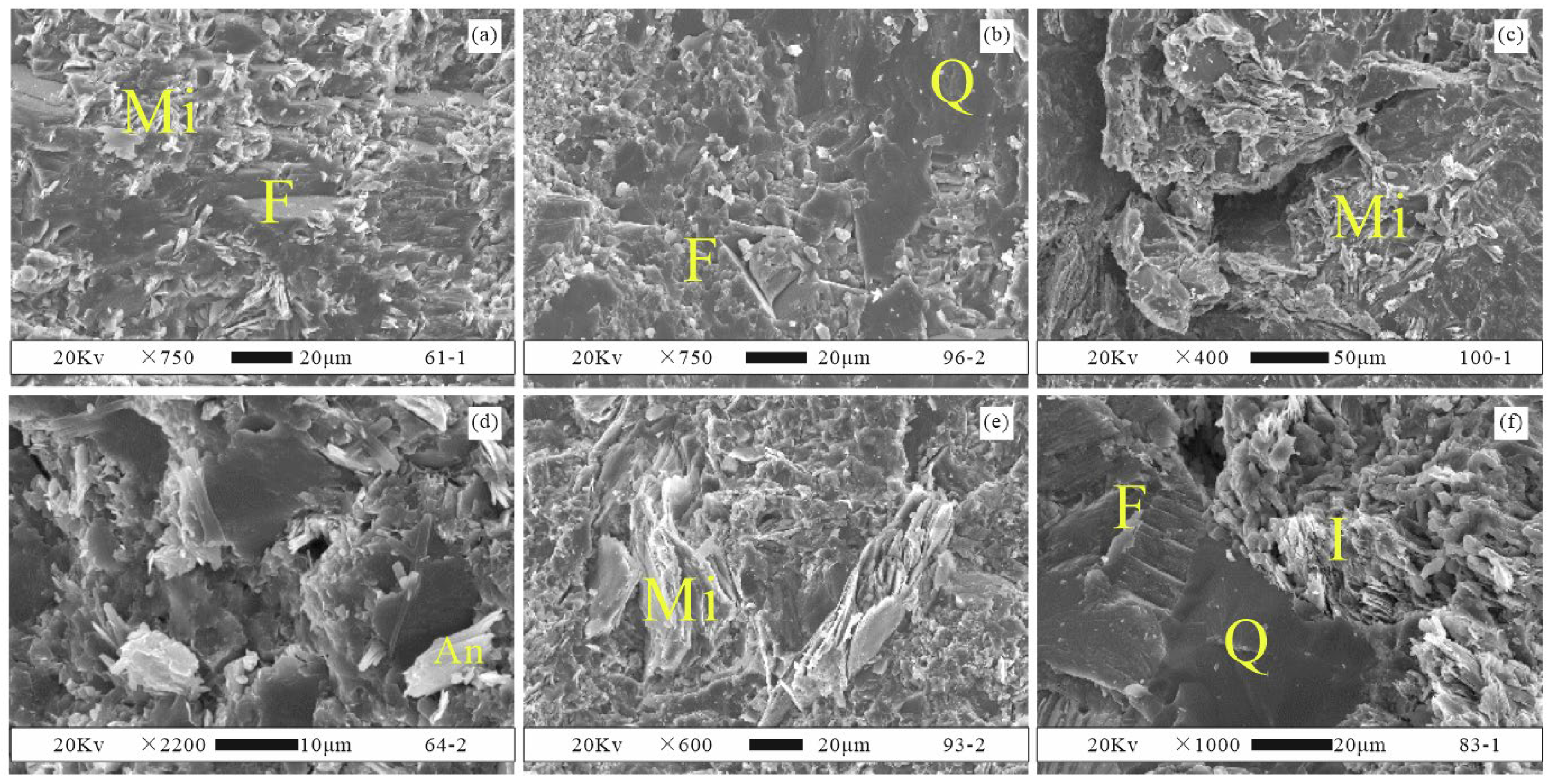
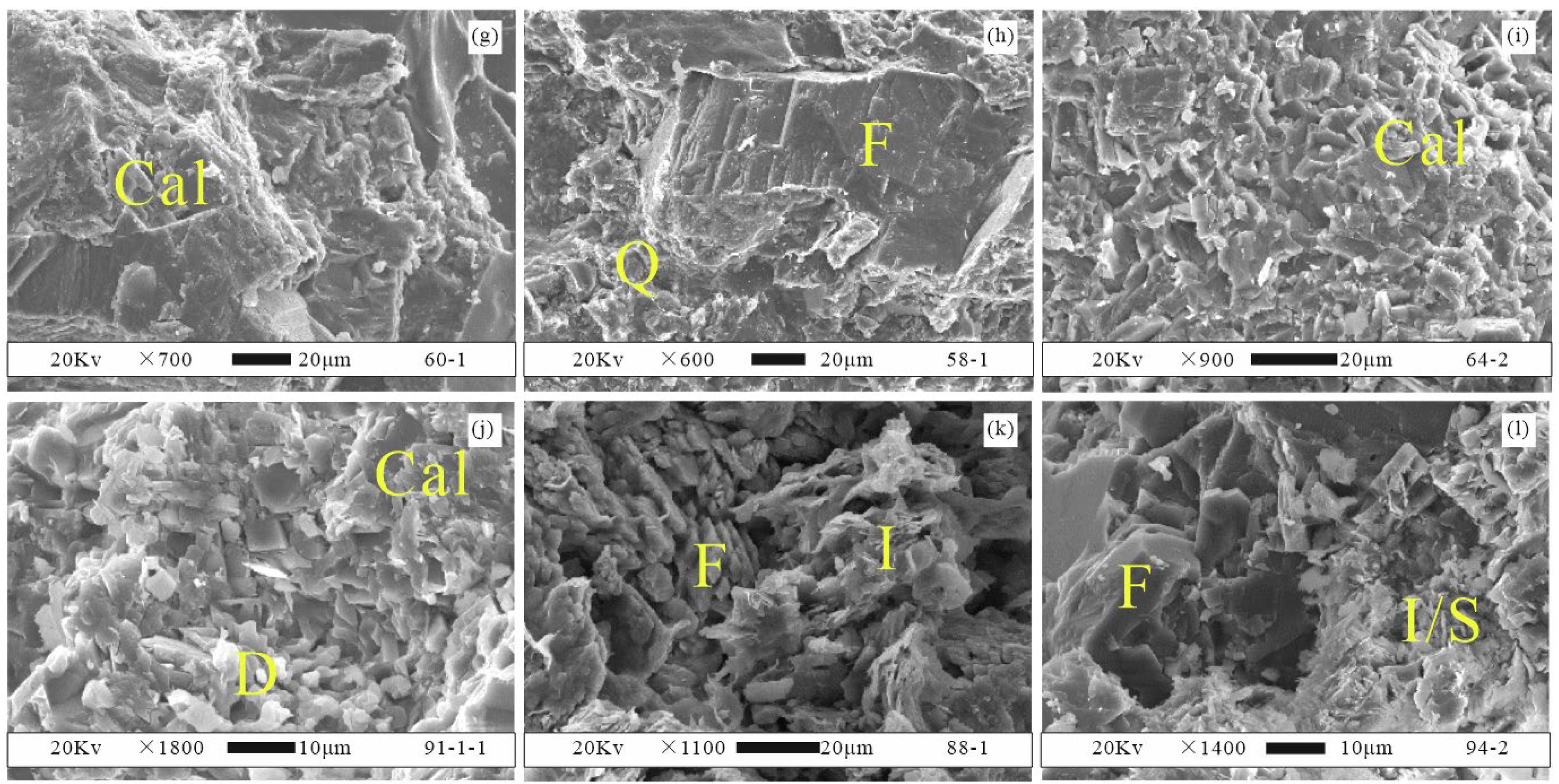

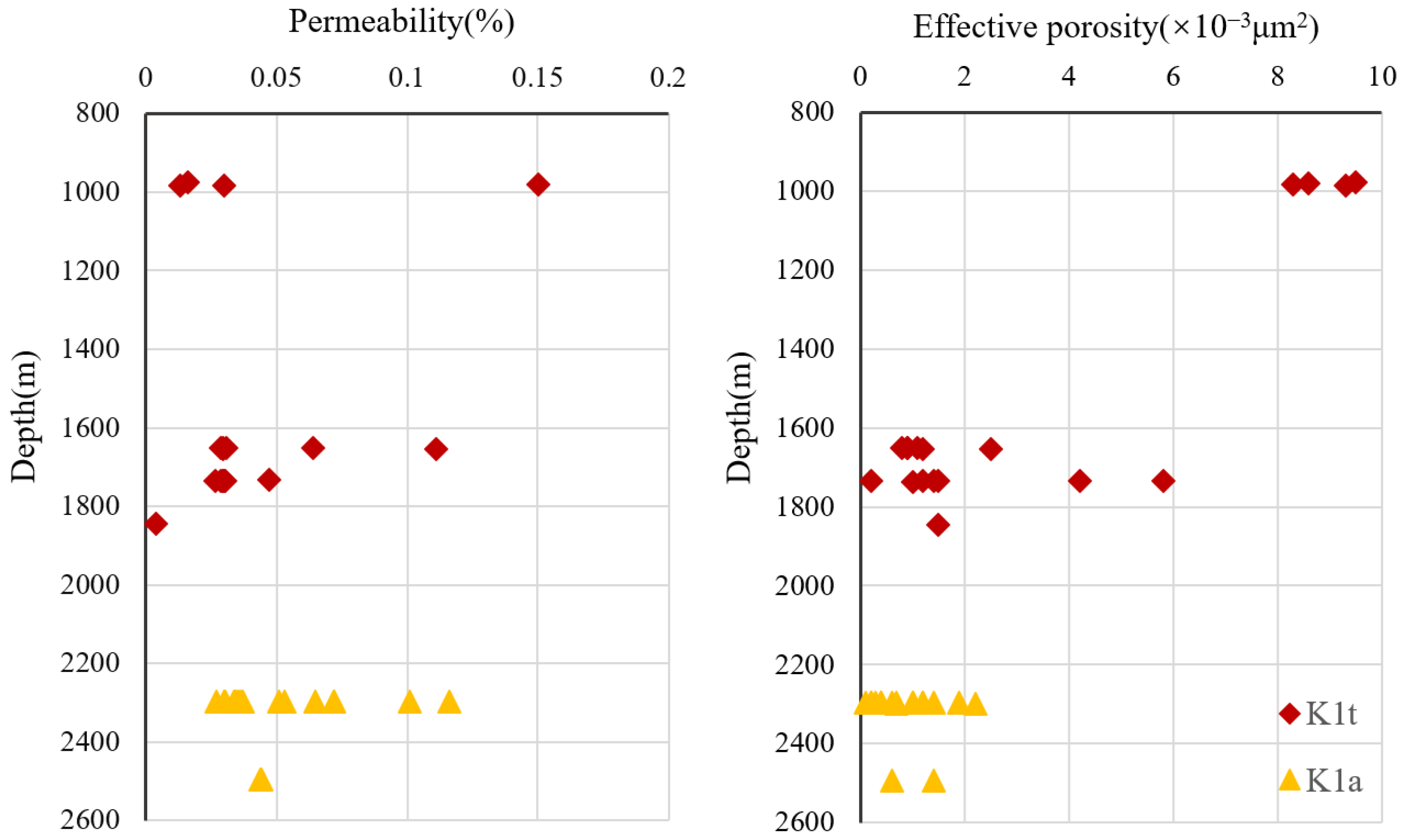
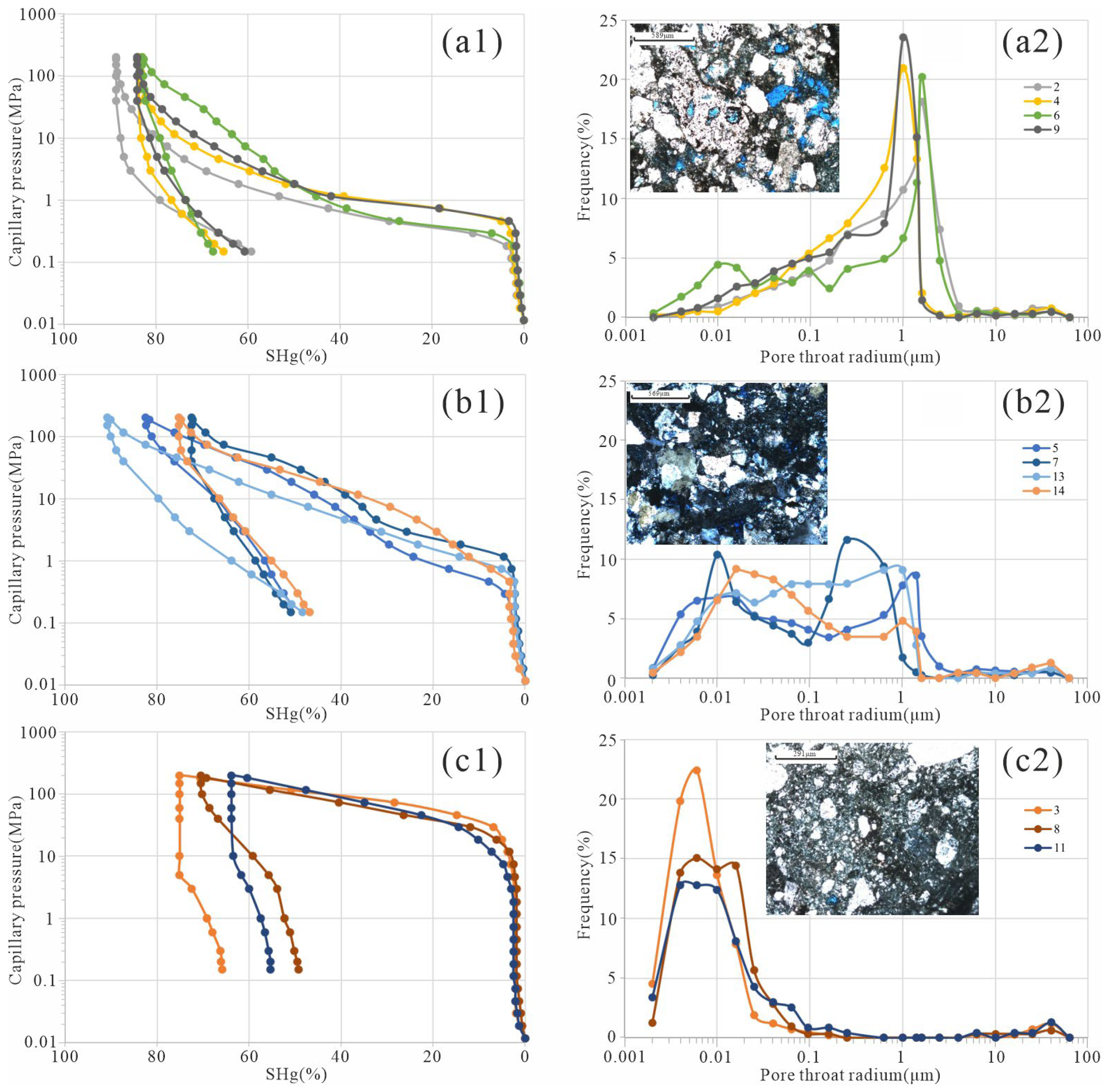
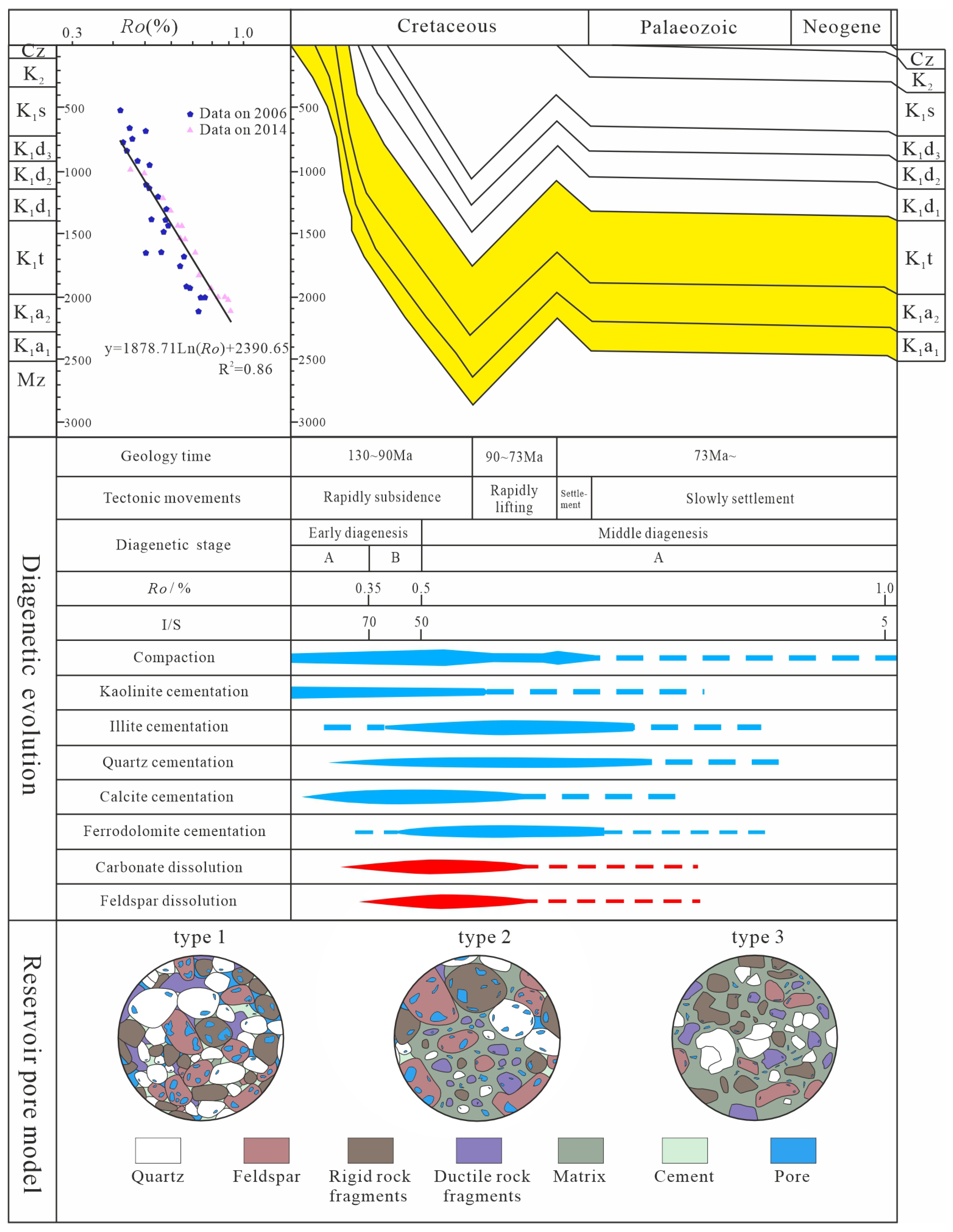
| Well | Depth (m) | Formation | Terrigenous Clast (%) | Terrigenous Clast (%) | Compositional Maturity | ||||||||||
|---|---|---|---|---|---|---|---|---|---|---|---|---|---|---|---|
| Quartz | Feldspar | RF | Rock Fragments | ||||||||||||
| Alkali Feldspar | Plagioclase | Volcanic Rock | Sedimentary Rock | Metamorphic Rock | Intrusive Rock | Tuff | Mica | ||||||||
| Acid | Intermediate -Basic | ||||||||||||||
| S1 | 1655.6 | K1t | 85 | 19 | 10 | 6 | 65 | 7 | 2 | 15 | 23 | 16 | 2 | <1 | 0.23 |
| S1 | 1656.0 | K1t | 81 | 26 | 12 | 7 | 55 | 10 | 1 | 8 | 26 | 7 | 3 | <1 | 0.35 |
| S1 | 1734.8 | K1t | 88 | 37 | 21 | 14 | 28 | 5 | 0 | 0 | 20 | 0 | 2 | 1 | 0.59 |
| S1 | 1735.9 | K1t | 78 | 24 | 14 | 7 | 55 | 11 | 1 | 5 | 22 | 13 | 3 | <1 | 0.32 |
| S1 | 1736.8 | K1t | 77 | 26 | 16 | 8 | 50 | 10 | 1 | 4 | 22 | 10 | 3 | <1 | 0.35 |
| Y1 | 749.1 | K1d2 | 72 | 34 | 12 | 7 | 47 | 10 | 1 | 2 | 30 | 2 | 2 | <1 | 0.52 |
| Y2 | 775.2 | K1d1 | 84 | 34 | 13 | 8 | 45 | 12 | 1 | 2 | 25 | 2 | 3 | <1 | 0.52 |
| Y2 | 778.4 | K1d1 | 69 | 37 | 13 | 9 | 41 | 10 | 1 | 1 | 23 | 2 | 4 | <1 | 0.59 |
| Y2 | 778.6 | K1d1 | 87 | 40 | 15 | 9 | 36 | 8 | 1 | 1 | 21 | 2 | 3 | <1 | 0.67 |
| Y2 | 1846.7 | K1t | 83 | 39 | 13 | 8 | 40 | 7 | 0 | 29 | 2 | 2 | <1 | 0.64 | |
| Y4 | 977.4 | K1t | 69 | 38 | 12 | 8 | 42 | 10 | 1 | 3 | 23 | 2 | 3 | <1 | 0.61 |
| Y4 | 981.1 | K1t | 76 | 30 | 11 | 7 | 52 | 11 | 1 | 8 | 26 | 3 | 3 | <1 | 0.43 |
| Y4 | 985.2 | K1t | 71 | 38 | 12 | 7 | 43 | 10 | 1 | 2 | 25 | 2 | 3 | <1 | 0.61 |
| Y4 | 986.0 | K1t | 66 | 40 | 12 | 8 | 40 | 11 | <1 | 2 | 23 | 1 | 3 | <1 | 0.67 |
| Y5 | 1202.2 | J | 88 | 40 | 12 | 9 | 39 | 6 | 0 | 0 | 28 | 2 | 2 | 1 | 0.67 |
| Y5 | 1202.6 | J | 84 | 39 | 12 | 8 | 41 | 6 | 0 | 0 | 30 | 2 | 2 | 1 | 0.64 |
| Y5 | 1209.4 | J | 84 | 40 | 12 | 8 | 40 | 5 | 0 | 0 | 31 | 1 | 2 | 1 | 0.67 |
| Y5 | 1401.8 | J | 86 | 41 | 12 | 9 | 38 | 5 | 0 | 0 | 29 | 1 | 2 | 1 | 0.69 |
| Sample ID | Depth | Formation | Average Throat Radius (μm) | Relative Sorting Coefficient | Sorting Coefficient of Throats | Displacement Pressure (MPa) | Type |
|---|---|---|---|---|---|---|---|
| 1 | 1654.26 | K1t | 0.5 | 0.17 | 2 | 0.73 | 1 |
| 2 | 1654.26 | K1t | 1.69 | 0.23 | 2.16 | 0.18 | 1 |
| 3 | 1733.62 | K1t | 0.01 | 0.29 | 3.54 | 29 | 3 |
| 4 | 1734.31 | K1t | 0.79 | 0.17 | 1.77 | 0.45 | 1 |
| 5 | 1734.91 | K1t | 0.79 | 3.22 | 3.22 | 0.29 | 2 |
| 6 | 1735 | K1t | 1.36 | 0.36 | 3.16 | 0.29 | 1 |
| 7 | 1735.51 | K1t | 0.24 | 0.38 | 3.61 | 1 | 2 |
| 8 | 1736 | K1t | 0.02 | 0.36 | 3.96 | 18 | 3 |
| 9 | 2296.13 | K1a2 | 0.83 | 0.19 | 2.09 | 0.45 | 1 |
| 10 | 2296.33 | K1a2 | 0.33 | 0.28 | 2.63 | 0.73 | 1 |
| 11 | 2297 | K1a2 | 0.03 | 0.46 | 4.6 | 11 | 3 |
| 12 | 2297.2 | K1a2 | 0.45 | 2 | |||
| 13 | 2297.25 | K1a2 | 0.5 | 2 | |||
| 14 | 2298.1 | K1a2 | 0.45 | 2 | |||
| 15 | 2494.5 | K1a1 | 1.1 | 2 |
Disclaimer/Publisher’s Note: The statements, opinions and data contained in all publications are solely those of the individual author(s) and contributor(s) and not of MDPI and/or the editor(s). MDPI and/or the editor(s) disclaim responsibility for any injury to people or property resulting from any ideas, methods, instructions or products referred to in the content. |
© 2025 by the authors. Licensee MDPI, Basel, Switzerland. This article is an open access article distributed under the terms and conditions of the Creative Commons Attribution (CC BY) license (https://creativecommons.org/licenses/by/4.0/).
Share and Cite
Tian, H.; Ren, Z.; Qi, K.; Liu, J.; Guo, S.; Han, Z.; Yao, J.; Zhu, L. Reservoir Characteristics and Diagenetic Evolution of Lower Cretaceous in Baibei Sag, Erlian Basin, Northern China. Processes 2025, 13, 1391. https://doi.org/10.3390/pr13051391
Tian H, Ren Z, Qi K, Liu J, Guo S, Han Z, Yao J, Zhu L. Reservoir Characteristics and Diagenetic Evolution of Lower Cretaceous in Baibei Sag, Erlian Basin, Northern China. Processes. 2025; 13(5):1391. https://doi.org/10.3390/pr13051391
Chicago/Turabian StyleTian, Hongwei, Zhanli Ren, Kai Qi, Jian Liu, Sasa Guo, Zhuo Han, Juwen Yao, and Lijun Zhu. 2025. "Reservoir Characteristics and Diagenetic Evolution of Lower Cretaceous in Baibei Sag, Erlian Basin, Northern China" Processes 13, no. 5: 1391. https://doi.org/10.3390/pr13051391
APA StyleTian, H., Ren, Z., Qi, K., Liu, J., Guo, S., Han, Z., Yao, J., & Zhu, L. (2025). Reservoir Characteristics and Diagenetic Evolution of Lower Cretaceous in Baibei Sag, Erlian Basin, Northern China. Processes, 13(5), 1391. https://doi.org/10.3390/pr13051391





